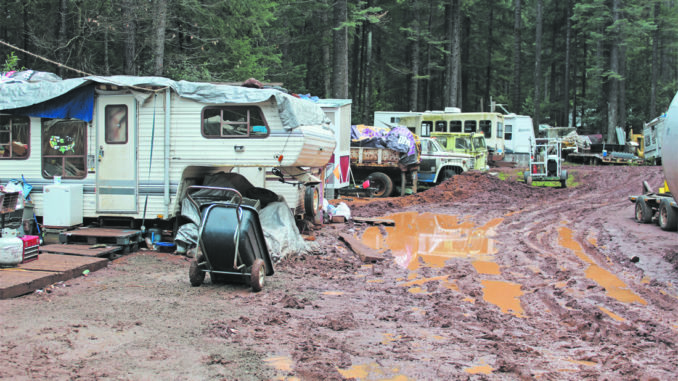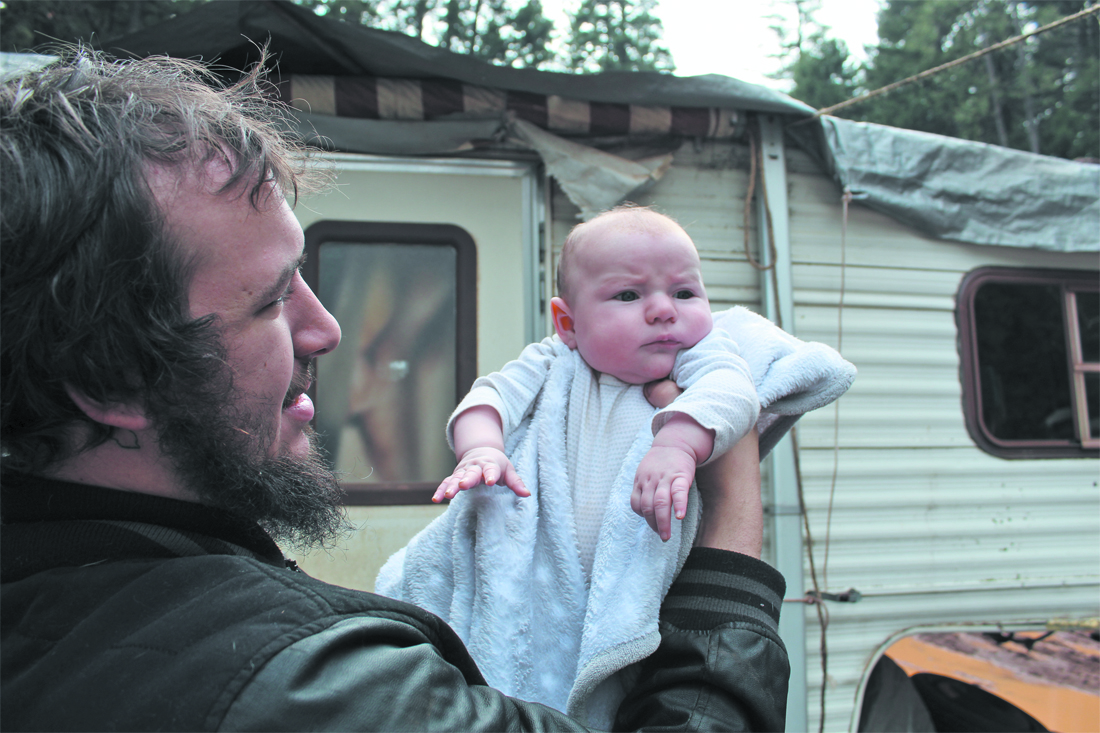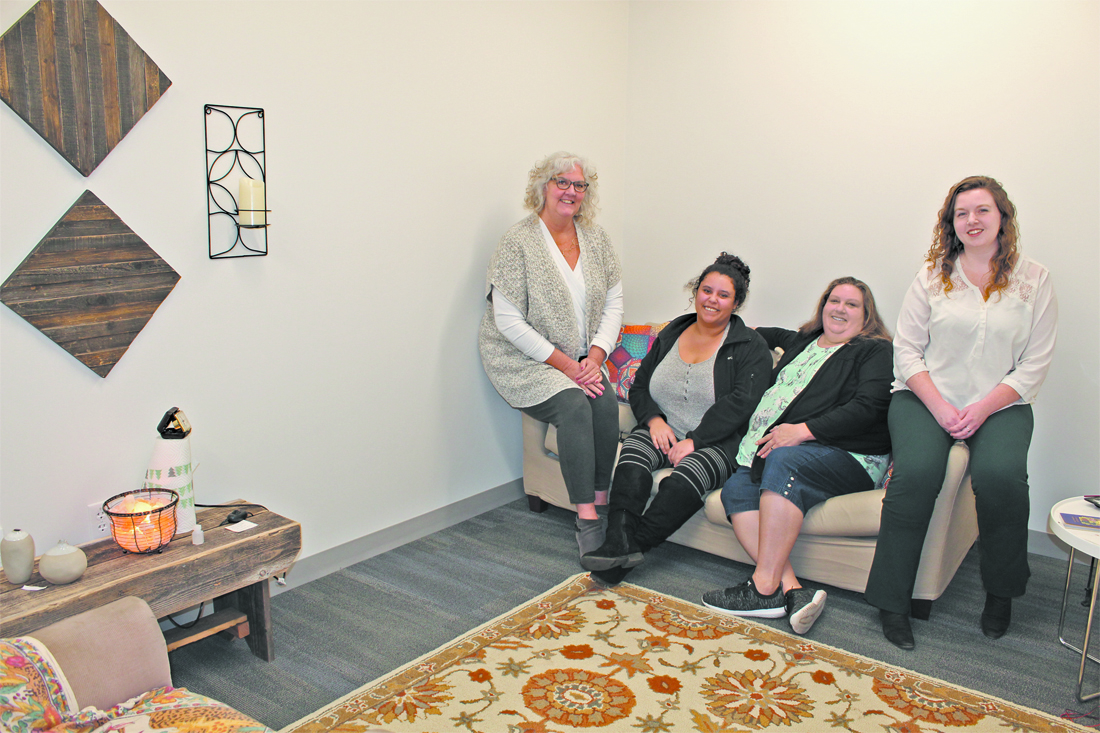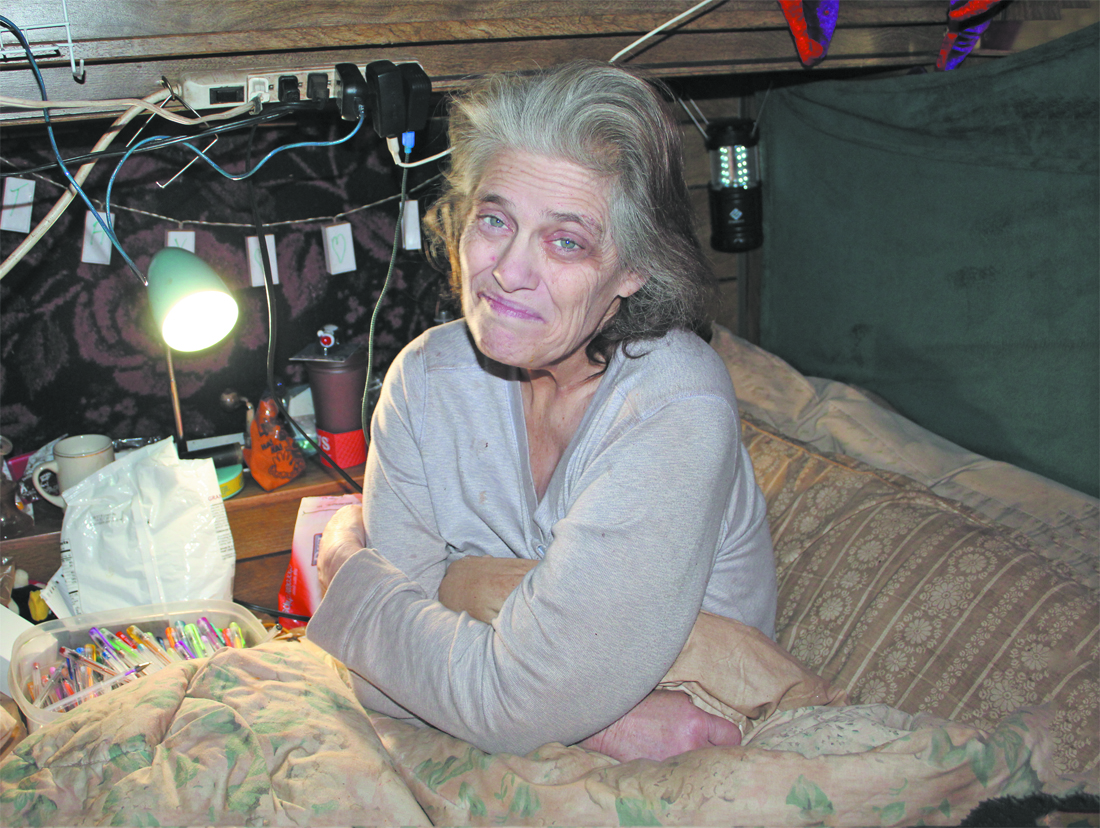
A property in Magalia where several survivors have landed.
Juliette Chestang came back home to the Ridge in 2017. She’d been away for about 15 years, but after a long-term relationship didn’t work out, she turned to family for stability.
She rented a room from her parents at their home in Magalia and got a seasonal job at a tax preparation company off the Skyway in Paradise. Things were looking up.
Then the Camp Fire hit. And Chestang found her life upended again.
Her parents lost everything and moved in with her sister, who’s raising a family. It was cramped, Chestang said, and she didn’t want to impose. So, for the past 16 months, her car has been home.
Day-to-day, everything seems to take twice as much effort, she told the CN&R. To stay organized, Chestang categorizes and bags her belongings (socks, toiletries, bras, etc.). She’s implemented “a lot of camping-style measures”—keeping cleaning wipes handy, for example—and has been eating more snacks and fast food than she ordinarily would.
Starting over has been difficult, even with support from family and friends. Chestang submitted a claim through the Federal Emergency Management Agency after the disaster—ending up with just over $100, she said.
Since then, Chestang has been unable to find employment or affordable housing.
“My job is just surviving,” she said. “You don’t have time to think about long-term plans. You’re too overwhelmed by your immediate needs.”
Chestang’s story isn’t uncommon. Sixteen months after Nov. 8, 2018, many Camp Fire survivors—particularly those who are low-income, under- or uninsured—are still stuck in survival mode. They’re living in cars, rundown RVs, even in tents scattered around the Ridge and elsewhere. Local service providers and government agencies are aware of the problem, but lack the resources to address the extent of the crisis fueled by a perfect storm of events—a disaster in a region already plagued by poverty and a housing shortage. The situation in Butte County is dire, its aftermath drawing parallels to that of Hurricane Katrina.

Juliette Chestang has been living in her car since the Camp Fire.
Faced with no other options, many survivors have decided to relocate. But not everyone has the resources to start over in a new community.
For Chestang, it’s not as simple as getting in her car and driving away. The Ridge is her home. She grew up there, as have generations of her family. Moreover, her father has suffered multiple strokes since the fire, and she wants to be near him.
“Without family, what else do you have?” she said. “I can’t very well just leave my family when they’re in this fucked-up position, too. It happened to all of us, and now we’ve all got to work together to get ourselves better.
“We’re all hurting. I just don’t know how to get out of it yet.”
Shades of Hurricane Katrina
Nicole LiBaire began her disaster recovery work in Louisiana three years after Hurricane Katrina devastated New Orleans and the surrounding area, killing more than 1,800 people. She founded and directed a statewide housing authority in order to distribute housing vouchers to survivors who would eventually come to live in 3,000 permanent supportive housing units throughout Louisiana.
But that housing wasn’t built overnight. The challenges the state experienced when it came to managing recovery as people waited for places to live mirror what is happening in Butte County, LiBaire said. She’s been coming here over the past 14 months to work with the Butte Countywide Homeless Continuum of Care through her role as a senior associate with the Technical Assistance Collaborative (TAC), a national nonprofit that helps communities implement policies related to health care and affordable housing, among other things.
With the hurricane, LiBaire said, the shells of buildings were left standing. Years after the disaster, poor people were squatting in the flood-damaged structures. She met some of them while performing homeless census counts.
“[The buildings] were so full of mold, and you’re talking years of just rot at that point—just nothing that anybody should live in,” she said. “But when you’re faced with living on the street, the fact that you might be able to get in and out of the rain is a better option for you.”
Like in Butte County, nonprofit and private organizations in Louisiana came together to try to fill the gaps, she said. Some people were able to get the help they needed to get housed and start over, but many were stuck either living in unsafe or unsuitable conditions not meant for long-term use, or were forced to move out of the area, LiBaire said.
She predicts a similar outcome locally.
“Sadly, what it means is people having to relocate,” she said. “And you’re talking about people that have probably lived in [Butte County] their entire life, and they probably don’t know what it takes to relocate or have the means to relocate, nor do they want to, because this is where they’re from.”
Ed Mayer, executive director for the Housing Authority of Butte County, said people have settled into traditionally temporary living situations because the region has a “severe demand for housing that doesn’t really exist.”
The county was in the midst of a housing crisis before the fire, he noted. It was greatly amplified after tens of thousands of people across the Ridge lost their homes overnight. The rebuilding by well-insured homeowners—55 homes completed in Paradise and 24 in unincorporated Butte County thus far—doesn’t address the loss of rentals, including the dozens of razed mobile home parks, that previously housed the low-income population.
There are affordable housing projects in the works countywide that could provide relief. The housing authority alone is involved with plans for 168 units for seniors, 112 units for families and 72 units for singles at new apartment complexes across Gridley, Chico, Orland and Oroville, Mayer said. The problem is that the timeline for completion is uncertain: Mayer said the projects are waiting on state and federal affordable housing grants, loans and subsidies, which typically are extremely competitive because of the statewide need.
In the meantime, there are few local options for those in desperate need of help, he said.
Nowhere to go
In the lobby of the Magalia Community Church’s recovery center, Doreen Fogle greets hundreds of Camp Fire survivors four days a week. The church has served as ground zero for volunteer relief post-Camp Fire, offering basic necessities such as food, clothing and toiletries.
Chestang was there on a recent afternoon, gathering supplies for herself and her family. But first, she checked in at Fogle’s table in the lobby, where those seeking resources go through a brief intake process.
According to data collected by the church, an average of 220 people per day have visited its recovery center since August.

Tyler Weist and his infant son pictured in January.
In January, for the first time, a slim majority reported finding housing (either purchasing a new home or securing a rental). However, many still are living in precarious situations, Fogle said.
That same month, 605 told church officials they were living in an RV or trailer, 183 in a home with friends or family and 91 in temporary FEMA housing. At the same time, in the middle of winter, 92 reported living in vehicles, tents, sheds, shelters, hotels/motels or that they were couch surfing or living on the streets.
Take, for example, a property in Magalia the CN&R visited in January. The temporary homes were packed tightly together, without traditional RV pads and hookups. Some parts of the parcel were impossible to walk through—residents laid wooden boards down to get across muddy ruts with massive puddles that had pooled up after recent storms and emitted an acrid smell.
One resident, Tay Hodges, is disabled and uses a wheelchair. She told the CN&R she has nerve damage that causes such intense pain in her feet that it feels like “walking on broken glass or nails.” While she was quick to offer a smile, Hodges said she battles depression. Financial and health troubles, including diabetes, are almost always the trigger.
Hodges and her boyfriend lived in a trailer park on the Ridge before the fire. It didn’t burn down, but they weren’t able to return, she said, and they received no assistance from FEMA. They ended up at the Red Cross shelter at the Silver Dollar Fairgrounds, but not for long. After they were kicked out with a little over $100 and nowhere to go, Hodges said, they stayed at random places, including a motel, a friend’s van and the city of Chico’s warming center.
For most of the past year, they lived in a tent, first in Chico and then in Magalia. It was a humbling experience. “I peed and pooped in a cup,” Hodges said. “You wrapped a tarp around yourself and did what you had to do and that was it.”
During that time, Hodges struggled to manage her diabetes and was briefly hospitalized.
About five and half months ago, things improved when the couple secured an RV. It has a ceiling leak and broken pipes, but they told the CN&R they’re grateful—Hodges said her bed is comfortable, and they’re out of the elements.
She doesn’t have much hope about finding long-term housing. The couple’s income is $1,000 per month from Hodge’s Supplemental Security Income check, and not much is left after expenses, she said.
“Our biggest thing is we don’t have money,” Hodges said. “I can’t afford a rental.”
Other residents of the makeshift community told the CN&R they have had a hard time finding a job, and that transportation is a major issue—they either don’t have a vehicle or what they do have is in disrepair. Like Hodges, they say finding an affordable place to rent in a better location seems improbable, if not impossible, considering the inflated post-disaster prices.
Tyler Weist, his girlfriend and infant son ended up on the property for similar reasons.
The couple used to live in a mobile home with Weist’s mother on his grandfather’s Magalia property, he said. After it burned, they moved around. The couple stayed at a Red Cross shelter in Glenn County for a while. Once it closed, they moved into an apartment in Chico with family, only to be displaced again when the lease wasn’t renewed. That’s when Weist found an old RV listed on Craigslist for $500.
Weist said it leaks and the fridge and oven don’t work. One night, the family had to rush out because they feared an electrical fire was igniting.
It isn’t the first time the couple had lost everything—their apartment in Ventura burned down during the Thomas Fire in December 2017. That’s when they moved back to Magalia, where Weist spent most of his teenage years.

The staff of Butte-Glenn 211 grew after the Camp Fire in order to handle a call and text volume that quadrupled, primarily due to survivors seeking resources. Pictured, from left: Tara Sullivan-Hames, Rina York, Tracey Gillihan and Molly Jolliff.
In January, he told the CN&R he was looking to find work out of state in order to support the family. In the meantime, the couple had been scraping by on government assistance programs.
“I’ve just been busting my ass trying to get back on top,” he told the CN&R. “My main goal is to get them out of here … in a more suitable, stable environment.”
Relief, not recovery
Dozens of local organizations have been on the front line of disaster response, assembled through the collective called the Camp Fire Long Term Recovery Group. Comprising public entities, businesses, nonprofits, community groups and faith-based organizations, the group focuses on identifying and meeting ongoing and long-term needs post-Camp Fire.
One organization in the recovery group is the call center Butte-Glenn 211, part of the nonprofit Help Central Inc., which connects locals to an array of social services and resources.
The staff had crisis response experience back in 2017, when the Oroville Dam Spillway threatened to collapse, so operators were prepared when they began answering calls on Nov. 8, 2018, “as soon as people were starting to recognize there was smoke in the air,” said Tracey Gillihan, Butte-Glenn 211’s call specialist team leader. They directed Ridge residents to evacuation routes and shelters.
Afterward, the call center went through several phases. First, people phoned in with inquiries about whether their homes were still standing and when they could return. The staff often had to break the bad news that the caller’s house was gone. When relief services emerged, Butte-Glenn 211 directed people to distribution centers, emergency housing programs, free transportation services, medication assistance and more.
The organization’s call and text volume has nearly quadrupled post-fire, said Executive Director Tara Sullivan-Hames. Through grant funding, the organization has tripled staffing to respond to the increased demand. It also operates a Camp Fire information text line with more than 10,000 subscribers and recently launched one targeting Gridley. There are plans to roll out ones for Magalia and Concow/Yankee Hill, too.
Butte-Glenn 211 focuses on making a meaningful connection with clients and building trust, so that it is viewed as a valuable, accurate resource that can empower people during times of need, Sullivan-Hames said. What has made things difficult for the call center lately is that there is no strategic, long-term plan they can share with people who lack the resources to rebuild.
“The trajectory of this disaster is not allowing the response to fully move into a recovery mode, and yet that’s kind of where our government agencies have gone,” she said.
“The recovery phase is really about being rehoused and stability,” she continued. “What’s happened with this response and this disaster [is] we don’t have housing, and so we’re just almost kind of stunted. We’re stuck in this relief mode for our community’s recovery because we can’t get people stably housed.”
The high call volume remains to this day. Sullivan-Hames attributes it to the challenges of the recovery and lack of available resources: People still need help with housing, food, propane and transportation. This winter, Butte-Glenn 211 heard from survivors seeking tarps for leaking RVs and tents.
“They’re very difficult calls because they’re super complex, and it kind of gets to my heart when I’m still giving people [resources for] these most basic of needs this far out. … [It’s hard] to imagine having to live in that state for this long,” Gillihan said.
‘Long way to go’
In the aftermath of the Camp Fire, disaster case managers arrived to help people navigate their next steps. When federal government helpers left Butte County around June, community organizations stepped in to fill that role.

Tay Hodges, a disabled survivor with diabetes, lived in a tent for much of the past year. She recently secured a leaky RV and says she cannot afford a rental on her limited income.
There currently are 33 disaster case managers (12 part-time) tasked with helping survivors obtain housing locally, relocate and receive financial and employment assistance as well as emotional support and other resources. Some are FEMA-funded through Northern Valley Catholic Social Service and the Society of St. Vincent de Paul, while others are volunteers or privately funded by the Butte Strong Fund.
In January alone, the case managers closed 165 cases after helping clients achieve their recovery plans or receive financial assistance for housing. However, the unmet need is staggering. More than five times that amount—876 cases—remain open. Moreover, a waitlist established in August—nine months post-fire—includes 2,741 households that have yet to be assigned a case manager.
The community needs to make it a high priority to help these people, Sullivan-Hames, of Butte-Glenn 211, told the Butte County Board of Supervisors during a presentation at its Feb. 25 meeting.
“Many survivors are confused and uncertain about their next steps, and they really are struggling to know how to navigate their recovery while they wait for a case manager,” she said. “Just having them wait for a case manager is not … a productive solution.”
Shelby Boston, director of the Butte County Department of Employment and Social Services, was hoping to present some good news that day. Her department applied for an AmeriCorps and California Volunteers grant to hire more disaster case managers.
Last month, the department was tentatively awarded a $1.1 million grant. The caveat: It’s contingent on matching funds. The county asked for and subsequently received an extension to reply to the offer in order to apply for $1.2 million from the Butte Strong Fund—a fire recovery fund held at the North Valley Community Foundation—to bring an additional 57 case managers on board.
“I’m really hoping to find a solution and continue to move forward,” Boston told the CN&R.
In general, grants have been awarded to help address the housing crunch post-Camp Fire, but they largely have been geared toward homeowners. The town of Paradise, for example, recently received $23 million in CalHome funds to distribute low-interest loans for rebuilding.
Town of Paradise Housing Program Manager Kate Anderson said the municipality was home to approximately 36 mobile home parks that burned, and all of its subsidized apartments—a total of 88 units—were destroyed. Most of the owners of the latter are planning to rebuild, and she’s heard of at least four mobile home parks that want to reopen and a few complexes that survived the fire and are reopening.
However, Anderson acknowledged the gaps in resources for survivors, particularly renters, and said her department wants to explore how to create programs to incentivize the rebuild of rental housing and apartments.
One resource that could help on that front is the $1 billion in federal Community Development Block Grant Disaster Recovery funds for California communities devastated by the 2018 wildfires. The money is earmarked specifically to address unmet housing, infrastructure and economic needs. The California Department of Housing and Community Development has until June 3 to finalize an action plan for disbursement of the funds, which will then be reviewed by the U.S. Department of Housing and Urban Development.
Casey Hatcher, deputy administrative officer for Butte County, said that local jurisdictions don’t know how much they could receive or when. She added that the county still is waiting for such disaster recovery funds from the October 2017 Cherokee Fire, which burned more than 8,400 acres and destroyed six structures.
The town of Paradise wants its renters, which include seniors and veterans, to be able to come back, Anderson said. The hardest part is that there’s nowhere for them to go while they wait for the rebuild because the market is so impacted.
“While it’s good that we have some that we can help, it’s frustrating that we can’t help far more people,” she said. “We don’t want to keep losing people and have people give up hope.”
The county’s Department of Employ-ment and Social Services received a $1 million grant from the Butte Strong Fund in early 2019 to help people move on to the next phase of their recovery. The money has helped residents get water tanks and pay for repairs to vehicles and RVs, Boston said. It has helped people relocate, too.
Recently, a man who had lived in a metal cargo container for almost a year received assistance purchasing an RV that allowed him to rejoin his wife and her family in another state, Boston shared as an example.
“He just texted me the other day, in fact, and he is doing well there and looking forward to coming back to Paradise in the spring,” Boston said. The couple plan to rebuild.
While she has success stories like this to share, Boston also recognizes that many people are falling through the cracks. Many don’t qualify for traditional government assistance programs. Those who were sharing a home or couch surfing, for example, did not qualify for FEMA assistance because they were not on the lease or the property owner, Boston said.
That means the community has to get creative, and continue trying to remove barriers, she said.
“When those individuals come onto our radar, we try to help them as much as we can,” she said. “We can’t forget. We can’t leave people behind and think, ‘Oh, they’ll figure it out.’ … I think we’ve come a long way, but we have a long way to go.”
